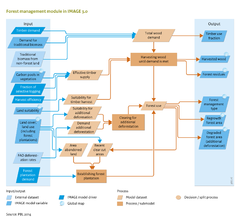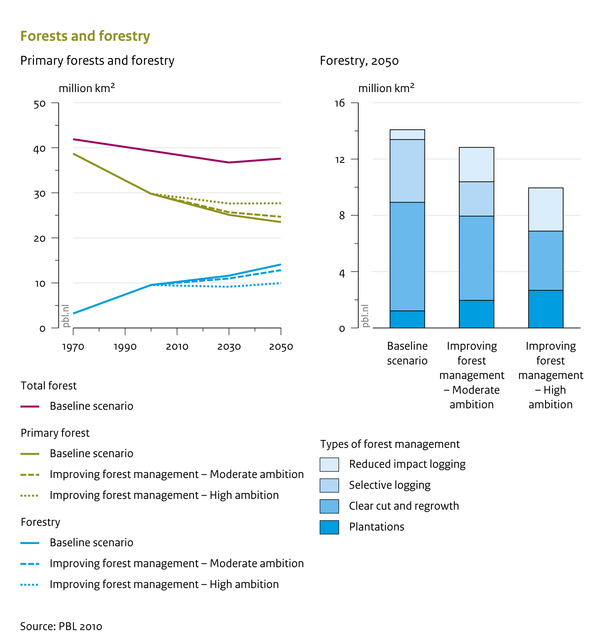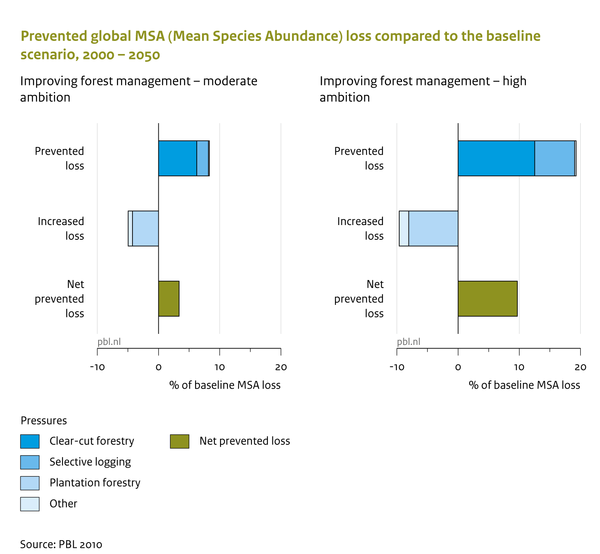Forest management/Policy issues
Parts of Forest management/Policy issues
| Component is implemented in: |
| Components: |
| Related IMAGE components |
| Projects/Applications |
| Key publications |
| References |
Baseline developments
In most baseline scenarios, areas of managed forests increase. The IMAGE forest management model was used in the scenario study ‘Rethinking global biodiversity strategies’ on future biodiversity developments (PBL, 2010). The study projects that, in the absence of additional forestry policy, the area of forest plantations will increase only slightly between 2000 and 2050 (from 1.1 to 1.2 million km2). The total forest area for wood production will increase from 9.5 to 14.5 million km2 (the figure below, left panel). According to this projection, by 2050, just over a third of the global forest area will be used for wood production and consequently. In the same year, the area of primary forest, defined in IMAGE as established before 1970 and not exploited since, will decrease by more than 6 million km2 from almost 30 million km2 in 2000.
Policy interventions
Several policy interventions on forest management can be simulated in the IMAGE model 3.2:
- increase in production on highly productive forest plantations;
- increase in carbon storage to mitigate climate change;
- increasing harvest efficiencies, or using harvest residues for energy;
- more reduced impact logging (RIL) techniques, less conventional selective felling.
The scenario study ‘Rethinking global biodiversity strategies’ implemented the following two ambition levels for improved forest management as alternatives for the baseline trend (the figures above and below):
- Moderate ambition level: partial substitution of conventional selective felling in tropical forests with RIL techniques, and forest plantations targeted at supplying 25% of the global wood demand;
- High ambition level: full substitution of conventional selective felling with RIL techniques as of 2010, and forest plantations targeted at supplying 40% of the global wood demand by 2050. This represents a plausible future development of plantation growth (Brown, 2000).
The ambitious improvements in forest management will result in considerably less land used for forestry by 2050 (about 10 million km2, or one third smaller area than under the baseline scenario) (see the figure above). With the reduced forest area, and the assumed positive effects of RIL techniques, biodiversity loss caused by forestry will be reduced. For the lower ambition level, gains will be smaller with forestry area expanding well over 3 million km2, and less biodiversity loss prevented.
Effects of policy interventions on this component
| Policy intervention | Description | Effect |
|---|---|---|
| Expanding Reduced Impact Logging (*) | Increasing the share of produced wood yielded with Reduced Impact Logging (RIL) practices instead of conventional logging practices. (Reference:: PBL, 2010) | RIL leads to lower loss of biodiversity in forest areas, and it can have impacts on C pools and fluxes as less residues are produced per unit harvested wood product. |
| Increase forest plantations (*) | Increase the use of wood from highly productive wood plantations instead of wood from (semi-) natural forests. (Reference:: PBL, 2010) | Decreases the area impacted by forestry/logging |
| More sustainable forest management (*) | Sustainable forest management aims for maintaining long-term harvest potential and good ecological status of forests (e.g. the nutrient balance and biodiversity). This can be implemented by (i) enlarging the return period when a forest can be harvested again; (ii) only using certain fractions of the harvested biomass and leave the remaining part in the forests. | Because forests might supply less timber, more sustainable forest management lead to more forests to be used throughout the world (assuming no change in demand). |


